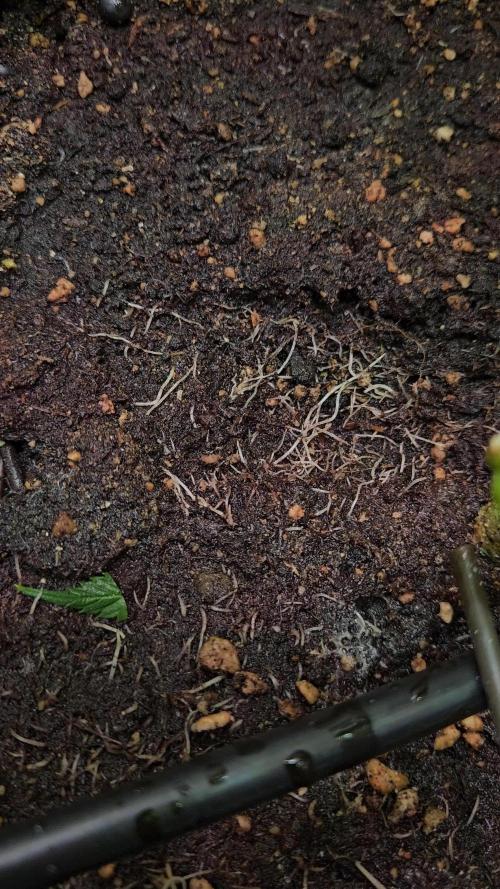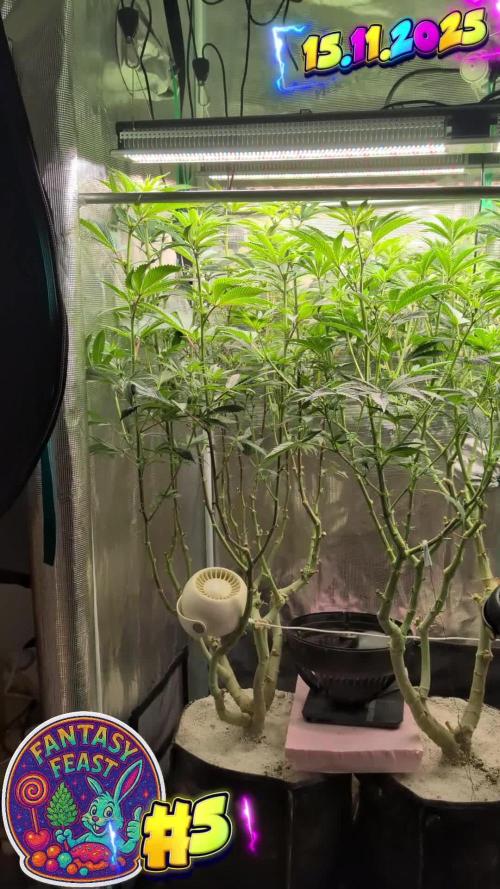The Grow Awards 2026 🏆 

























Likes
11
Share


@NOLOGIK
Follow
21/4
a beautiful plant, but this time the growth of the branches, had problems turning into each other! until it looks like a single bush !. now it's taking shape, because I cut all the extra leaves and twigs that were blocking the light. I look forward to!
Likes
3
Share


@TRPHAUS089
Follow
Defoiled, added a second net. Enhancer and npk booster also added every 2 weeks
Likes
107
Share


@Tropicannibis_Todd
Follow
ALRIGHTY THEN GROWMIES 😎
👉SHES PRETTY MUCH A BEAST , FROSTY AS HELL AND CANT WAIT TO CURE THEM UP AND GET SMOKEN 👈
👉I would recommend Shes had this incredible Berry aroma throughout her flowering 👈
Was a blast to grow thanks for hanging in there and following me on my journey👊
I GOT MULTIPLE DIARIES ON THE GO 😱 please check them out 😎
👉THANKS FOR TAKING THE TIME TO GO OVER MY DIARIES 👈
👉NutriNPK NUTRIENTS USED FOR FEEDING 👈
👉www.nutrinpk.com right now get 10% off using SPRING2022👈
Likes
7
Share


@Onlygrow99
Follow
Bien pues ya tenemos en marcha el 2º seguimiento del perfil...
Son 6 white truffles, 6 Apple&Bazzokies de GBSTRAINS y 5 GG4 de GBSEEDS que se empezaron a germinar el 15 de mayo por la tarde sobre las 19:00
Todas nutridas con BOOM nutrients jejeje
Todas las semanas iremos viendo los cambios y la evolución, los riegos y las flores que vendrán :)
El 16 de mayo del 23 sobre las 07:00 de la mañana pase las semillas del vaso con agua, a los tapers con servilleta. Ahí estuvieron 24 horas mas haciendo un total de 36 horas germinando para después,
pasarlas a las macetas de 1 litro.
22/05/23 actualizado, meto unas fotos mas de como van las semillas después de 7 días desde que se empezaron a germinar en el vaso de agua.
A día 22/05/23 llevamos 7 días desde que se empezaron a germinar.
ACTUALIZACION DE ESTADO:
30/05/23 Subo unas fotos después de 8 días.
Llevamos 15 días desde que se empezó a germinar las semillas en vaso de agua.
A partir de aquí, empiezo a contar semanas de crecimiento.
Trasplantaremos a maceta definitivas de 7L dentro de una semana o 2.
Processing
Likes
8
Share


@Peter_Panther_420
Follow
Girls are doing great the gelato and gg4 are already frosting up and there is bud sites everywhere these plants are stacked! Green crack still vegging but surely the stretch is coming soon they will be monsters 🤙🏼💯
Likes
20
Share


@RastaMouse
Follow
Ok my first grow on my new rdwc system made by urban Culture very exited to move to this I have done a lot of research and I know I will make mistakes but hopefully non too big. This is a step up from my Wilma 4 pot. I can get more in the system water wise and Easyer to clean out. Any advice or tips with rdwc feel free to comment 😎😊
Likes
8
Share


@G_abitbol
Follow
To me it looks like ready for harvest even thow I still have new pistils on main cola. I will flush one last time today. I will let the earth dry out and as soon as the leaves start to drop I will put into darkness for 48 hours and harvest. I think its good to give the plant a more natural rhythm as soon as you start flushing at least I have the feeling that it smells stronger now.
Likes
16
Share


@eldruida_lamota
Follow
Que pasa familia, vamos con la Segunda semana de crecimiento de estas Royal Gorilla de RoyalQueenSeeds, que ganas tenia de plantar esta variedad, no me cansaré de repetirlo.
Han progresado muy bien de las 7 que quedaron las 7 están bien verdes y van creciendo a buen ritmo.
Aplicamos en nutrientes la base de Agrobeta de crecimiento, y también empezamos aplicar bien con tucán y gold Joker.
Espero esta semana poder empezar con los trasplantes que también tengo ganas de pasarlas a maceta definitiva que ya lo van pidiendo.
Agrobeta:
https://www.agrobeta.com/agrobetatiendaonline/36-abonos-canamo
Mars hydro:
Code discount: EL420
https://www.mars-hydro.com/
Hasta aquí es todo,nada más:
Agradecer a James de Royal, Jose de Agrobeta, y a la empresa de Mars hydro, por los productos, que sin ellos estos proyectos no son posibles.
Espero que lo disfrutéis, buenos humos 💨💨
Likes
67
Share


@Dunk_Junk
Follow
Only a few days till I start staggered harvest. Whatever buds look ready I will cut off her.
Short video this week, sorry guys, technical problems 😑
Likes
91
Share


@Silky_smooth
Follow
At the start of week 12 she is doing very Amazing...buds are forming very nicely....🙏❤️
Likes
224
Share


@yan402
Follow
This two were part of another diary and got moved out due to space reasons at VW8 and moved back indoors at VW20
https://growdiaries.com/diaries/218151-auto-god-s-glue-grow-journal-by-yan402
13.09.25 VW21 Both are looking good and are developing tighter nodes than when they were outside, I'm going to have to keep cutting them back every once and a while I also applied nematodes against thrips and fungus gnats.
20.09.25 VW22 some spots and some yellow leafs, I think it's a root problem, probably root bound, but both seem healthy and are getting thicker so maybe just top up with Coco coir and give a slight different nutrient schedule less Tri Part Bloom could do the trick MAYBE lol.
27.09.25 VW23 Topped up the pots with extra coco coir and trimmed the side roots a bit, both plants were root bound 📹
03.10.25 VW23 did a HST/LST session 📹
12.10.25 VW25 Done a major HST session to try and keep them in line with the Sunset Sherbet GF I have going in the same tent, rest in the video 📹
17.10.25 VW25 ffj/fpj/fish 30 → 60 ml
19.10.25 VW26 it just became a one plant diary, keeping #5, #6 gets it's own diary for testing nutrients.
20.10.25 VW26(?) Feed tweak: added 3 g Calcium Nitrate/ 30 L (≈ 15 ppm N + 10 ppm Ca)
24.10.25 VW26 did a defoliation and trimming session 📹
25.10.25 VW26 I'll be repoting tomorrow, 26.10.25 VW27 rest in the video📹
27.10.25 VW27 Epsom Salt 0 → 2.5, Calcium Nitrate 3 → 9 g
01.11.25 VW28 CalMag 60 → 30ml, TriPartBloom 20 → 30ml, Magnesium 2.5 → 3.5g
04.11.25 VW28 no more yellowing between the veins and no new spots, the changes to the schedule worked, rest in the video 📸
09.11.25 VW29 Did what I'm hoping is a last cleanup 🎥
12.11.25 VW13 Did another cleanup in the tent 🎥, also switched to the FERMAKOR PK Micro schedule, (10.11.25) added Phosphoric acid as a pH down in preparation for flowering
🌱💦🌱💦🌱💦🌱💦🌱💦🌱
Day to day tasks & actions 🌿
🌱💦🌱💦🌱💦🌱💦🌱💦🌱
15.11.25 VW29 – no feed no water
16.11.25 FW1– no feed no water
(*RUNOFF reused for indoor house plants)
🍶💧🍶💧🍶💧🍶💧🍶
💧 Nutrients in 30 L #1 Veg — FERMAKOR
🍶💧🍶💧🍶💧🍶💧🍶
💧 Calcium Nitrate (Calcinit / Nitcal): 45 → 40 g
= 1.33 g/L → 207 ppm N + 253 ppm Ca
🍶 PK Concentrate (FERMAKOR Base): 30 → 40 ml
= 1.00 → 1.33 ml/L → balanced 1:1 P:K + light micros (from extract)
💧 Home-made FFJ/FPJ (Fish + Veg): 30 ml
= 1.00 ml/L
🍶 Epsom Salt (MgSO₄·7H₂O): 8 g
= 0.27 g/L → 26 ppm Mg + 35 ppm S
💧 Fetrilon Combi 1 (Micros): 0.5 g
= 0.017 g/L → Fe 0.7 ppm • Mn 0.7 ppm • Zn 0.3 ppm • Cu 0.3 ppm • B 0.1 ppm • Mo 0.02 ppm
🍶Phosphoric Acid (pH down) + Citric Acid (chelation): as needed
→ First set pH with phosphoric acid, then add a little citric only if you want extra chelation
💧 Target pH: 5.8 – 6.0 (drop test yellow-green)
📦 TOTAL: 60 → 70 ml / 48.5 g inputs per 30 L
= 2.00 → 2.33 ml/L + 1.62 g/L
⚙️✂️⚙️✂️⚙️✂️⚙️✂️⚙️
✂️ Tools & equipment ✂️
⚙️✂️⚙️✂️⚙️✂️⚙️✂️⚙️
✂️ 2× MarsHydro SP3000
⚙️ MarsHydro 150mm ACF Ventilator
✂️ Trotec dehumidifier (big unit)
⚙️ Mini no-name dehumidifier
✂️ Kebab skewers (LST – stainless)
⚙️ Wire + roast skewers (LST assist)
✂️ Scissors (HST)
⚙️ Vacuum (for spills & cleanup)
✂️⚙️✂️⚙️✂️⚙️⚙️✂️⚙️✂️⚙️✂️⚙️
🍒🍭🍬🌈🍒🍭🍬🌈🍒🍭🍬🌈🍒
🦄Fantasy Feast ( Seeds)🦄
🌈🍒🍭🍬🌈🍒🍭🍬🌈🍒🍭🍬🌈🍒
Species: Hybrid (Regular)
Genetics: The mother is Unicorn Whip by Dirty Bird Genetics. The father is Charcuterie by Cannarado Genetics.
Effect: Unknown Mixed effect body and head high
Flavor: Some phenos are Skunky gassy fruity, some are fruity sour citrus with a chemical touch and a touch of skunk
Flowering: Estimated 8–10 weeks
Resistance: Strong — Testing phase done
YouTube Link: https://youtube.com/-m8h?si=A7x4Zlr2kj-_ga31
Likes
5
Share


@FlyHighhh
Follow
Begonnen met voeding ,licht opgevoerd naar 250 watt . Ik ging eerst voor 4 planten maar kan het niet over mijn hart verkrijgen om die back up stek te deleten dus heb ik hem er maar in een kleine pot ertussen gepropt en hoop ik dat het straks in de scrogg allemaal.een beetje in elkaar gaat overlopen . 🤔🤔😏
Likes
4
Share


@Zoe_Spacecake
Follow
La planta crece bien al lado de una "dance Hall" que acabo de transferir desde tierra.
La maceta funciona muy bien, la planta crece de manera óptima, las raíces están bien blancas.
Hago este test con una planta. Hago podas para aprovechar todo el espacio disponible. Es una planta que crece muy rápido.





























